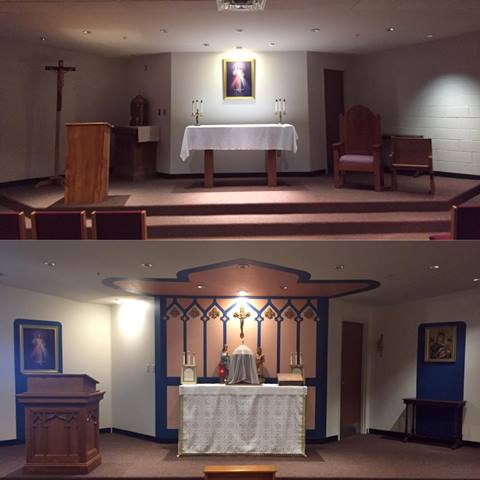And example of what young priests can do when they have a chance.
A chapel at a school: before and after.

Our “worship spaces” don’t have to be ugly.
Our churches and chapels reflect what we believe (or at least what the designers believed, if anything). But they also shape our belief.


































Great improvement! The tabernacle and crucifix right in the center, instead of tucked away in the shadows. Quite inviting. And the prie-dieu as a makeshift rail is a good thought.
Beautiful! Much improved. The tabernacle is now where it should be.
Churches like the top say, “I’m going to put Jesus in a dark corner, but I’ll put his picture front and center.” It would be like a man keeping a picture of his beloved as his cell phone background, but ignoring the real woman in favor of his favorite apps. Neither the image of Christ nor the wife are wrong, but we mustn’t prefer the copy over the real thing.
Much better.
I read someplace that celebrating the Novus Ordo on an altar with a tabernacle is prohibited. Is this true?
Definitely a great improvement. The changes themselves weren’t numerous but they were significant.
Nice job! I always like to see before and after pictures where churches become more reverent. When inside one, it’s hard not to think about how a sad 1970’s church can be improved. I find these architects really inspirational:
http://www.stroik.com/portfolio
http://www.mccreryarchitects.com/portfolio/
Great use of adding some color, and Jesus front and center, not back in the shadows somewhere.
Big improvement!
“Our ‘worship spaces’ don’t have to be ugly.”
Indeed! To that point, in the First Things podcast (2/27, “Spirit and Form”) they talk with Matthew Schmitz about his article in the Catholic Herald. I can’t remember who in the podcast made the point, but the hypothetical was this. Say there are two churches on opposite sides of the tracks. One is painted in drab colors, the churchyard is a simple lawn, has simple decorations and rustic furniture, the altar is bare, and the tabernacle is made of simple materials. The church on the other side is brightly painted, statuary present throughout the yard, the windows are colorful stained class, and the interior is lavishly decorated.
Which is the church full of the poor and for the poor?
Is it the case that the steps up to the altar have been removed and the altar is now at ground level?
Scotus…..I do not think the steps were removed.. looks as though the photo was just taken closer to the altar.
The second pic is from a slightly higher elevation too.
bushboar— As I read the documents it’s allowed but not recommended or preferred. This is what the GIRM says:
128 & 129 refer to 1967’s Eucharisticum Mysterium # 53 & 55 (I’ve included 54)
Very good start, most importantly with providing an appropriate place of honor for the tabernacle. I hope they’re able to continue making gradual improvements over time. I think there’s even more the pastor, or perhaps even better, appreciative alumni, can do to continue to improve the sacred character of the chapel.
As I read about the histories of some of the great cathedrals of Europe like St. Peter’s or the Duomo of Florence that inspired St. Peter’s dome, the idea of a church being “finished” has started to seem mistaken to me.
As we should keep growing and improving spiritually, I think it’s likewise worthy to try to continue to make our churches and chapels progressively better and better spaces for worship…or to progressively reverse the damage done by others. Even with the resources of the Vatican States to provide ample skilled labor and high quality materials, Bernini spent 50 years on the interior of St. Peter’s, and he was not the only contributor.
It seems there was an intermediate step of adding some lights above the tabernacle’s former location… maybe they’ll add some statuary there later.